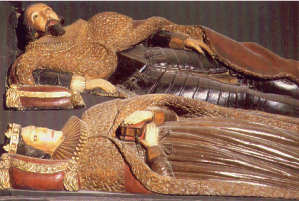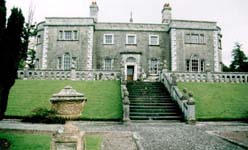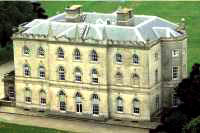
English common law contained the concept of 'coverture' by which a woman when she married, lost her legal rights as an individual. She could no longer own property, make a contract or keep her earnings. Her husband was the legal parent of her children and she had no right to custody of them in case of separation.
The rich tried to protect their daughters from material hardship by setting up trusts for them which were controlled by male relatives or friends. Women whose families and friends could gain them access to courts of equity might also get a sympathetic hearing. These laws, however, helped keep women subordinated as it was impossible for the majority of married women to obtain funds for trusts and legal actions. The situation of poorer women who were victims of domestic violence, infidelity, desertion or neglect could be hopeless.
There was great emphasis on carrying the family name into posterity through the male line. A family without sons might oblige the husband of an heiress to assume their surname as a condition of his marrying into an estate. However, a landowner could also 'entail' his estates to ensure that they would never be handed down through his female descendants. In that case, if one of his descendants had no son, the entailed estate would pass to his brother, nephew or even a distant male relative when he died but he could not leave it to his daughters.
| In early fifteenth century Louth the sonless Sir Bartholomew de Verdon could declare that 'as long as there is anyone bearing the name of the nation of Verdon, no daughter of his should have any of his lands.' Kenneth Nicholls, 'Irishwomen and property in the sixteenth century' in Margaret MacCurtain & Mary O'Dowd (eds.), Women in early modern Ireland, Dublin, 1991, p.27. |
Aristocratic titles were transmitted in the male line also.
Aristocratic and gentry families sought marriage alliances within or above their own class and income. Titled males, especially those belonging to the English aristocracy were considered the most prestigious marriage partners and wealthy merchants' daughters with substantial dowries were also sought after.
An early penal law designed to prevent intermarriage between Protestants and Catholics in Ireland made different provisions for Protestant men and women. A Protestant man married to a Catholic woman was given a year to convert her and if he failed, he was deemed to be a 'papist'. On the other hand, Protestant women with an interest in land worth £500 or over (heiresses, widows with dower claims, etc.) who married Catholics were deemed 'dead in law' and lost all legal right to property.
| The different penalties for men and women were due not so much to misogyny on the part of the legislators as to concern with the preservation of property - and hence, political power - in the ownership of protestant families. Under the normal rules of English common law, the ownership of the property of an heiress passed to her husband on marriage. Similarly, a husband was entitled to enjoy the land which his wife held by jointure or dower. If an Irish protestant heiress married a catholic, her property would, therefore, have passed into catholic ownership; and a widow's property would also have been controlled by her catholic husband. Mary O'Dowd, 'Women and the law in early modern Ireland' in Christine Meek (ed.), Women in Renaissance and early modern Europe, Dublin, 2000, p.104. |
Catherine Fenton (c. 1588-1630) married Richard Boyle, an Englishman who acquired vast estates in the Munster plantations and later became 1st Earl of Cork. By all accounts, he was a severe and determined man. Catherine gave birth to fifteen children in twenty seven years of whom six girls and five boys survived to adulthood. Her infants were sent after birth to 'wet nurses' for three or four years and many were then placed in fosterage for several more years.
Her husband considered women to be unreliable, emotional, lacking in self-control and concentration. He praised his wife for being 'most religious, virtuous, loving and obedient.' He supervised her housekeeping accounts, the purchase of her gowns and jewels and,
| ... would be creditors were instructed not to extend money on loan to his wife. Decisions relating to the education of their sons or the marriages of their daughters would appear to have been taken by [the Earl of] Cork with little consideration for his wife's views. Nicholas Canny, The upstart earl, Cambridge, 1982, p. 65. |
Anxious to extend his opportunities by marriage alliances, he opened discussions about the marriages of his six daughters when they were nine years old on average. One girl was sent to live with her future in-laws at six years, another at nine years, thus limiting their choice and their informed consent to their marriages. Two daughters were married when they were about thirteen years old.
| Thus, the patriarchal attitude of [the Earl of] Cork towards his daughters was made particularly manifest in the early age at which he sought to dispose of them through marriages which were primarily designed to enhance the political and social position of the earl and his sons. Nicholas Canny, The upstart earl, Cambridge, 1982, p. 90. |
His attitude to his sons was radically different. He took more care with their education, sent some of them abroad, began discussing their marriages when they were sixteen years old on average but believed it was important for men to exercise personal choice of partner and that early marriage was bad for their health. Richard Boyle's perspective on gender was fairly common in England at that time but the degree to which he put it into practice may not have been typical.
Catherine Boyle died a year after the birth of her last child. Her children were talented and one of her sons, Robert Boyle went on to become a famous scientist and discover 'Boyle's Law.' Her daughters Mary and Katherine were among the most educated and intelligent women of their generation. Mary's diary records her reading romances as a girl and her marriage in defiance of her father's wishes. Katherine lived with her brother Robert in London, made a brilliant impression in the same intellectual circles as he did and some of her recipe books survive.

Richard & Catherine Boyle as depicted on
their tomb in St Patrick's Cathedral, Dublin
Photographer: Peter O'Toole. Printed by John Hinde Ltd.
Mary Molesworth, Countess of Belvedere lived at Belvedere, near Mullingar, Co. Westmeath. She was locked away by her husband for thirty-one years because of allegations of adultery with his brother.
|
From 1743 onwards Lord Belfield locked his wife up at Gaulston where she was allowed to see nobody except the servants ... After twelve years of strict confinement she managed to escape and reached her father's house in Dublin, but he refused to admit her and within twenty-four hours she was back in her prison ... When her son came to release her ... her hair had gone white, she was dressed in the fashions of thirty years before and she had acquired a wild, scared, unearthly look. |
 Belvedere House near Mullingar, Co. Westmeath |
|
Lady Anne Ward and her husband Bernard disagreed over the design of the house they were about to build at Castle Ward, Co. Down in 1762. She was enthusiastic about the newly fashionable Gothic style with pointed arches but her husband was determined to build in the Georgian style. |
 The Gothic rear view of Castle Ward, Co. Down |